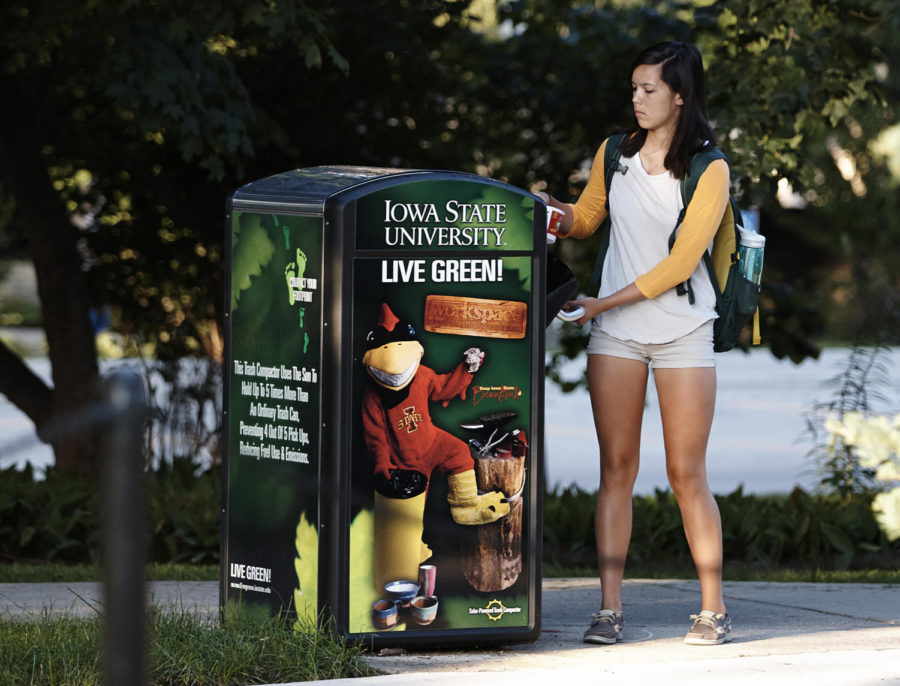Recycling process in Ames focuses on reducing waste
April 7, 2020
The city of Ames’ and Iowa State’s recycling program stands out among other communities with their ability to take advantage of the three Rs: reduce, reuse and recycle.
The university and city of Ames work alongside one another to combat the amount of waste that is on campus with a large number of students living in such a concentrated area. Various programs and facilities have been put in place to control waste management and recycling.
“Iowa State does single-stream recycling, which means all recycling goes into one bin,” said Ayo Oluwalana, recycling and special events coordinator for Facilities and Planning and Management. “From there it goes to Mid-America Recycling in Des Moines, […] and every six months, I do a follow-up with the Material Recovery Facility to make sure our recycling is being accepted.”
Students can request various recycling services, like cardboard pickup, single stream pickup, laboratory glass pickup and more through Iowa State’s Recycling Services.
“[Recycling] has to be an individual choice,” said Merry Rankin, director of sustainability at Iowa State and sustainability coordinator for the city of Ames. “Students must make the conscious effort to recycle and be aware of their individual amount of waste in order to make a change within their community.”
Mark Peebler, assistant superintendent for Resource Recovery in Ames, spoke on the process that goes into sorting through recyclable materials to find what can and cannot be accepted.
“Everything that people choose not to recycle or it’s contaminated and can’t be recycled, the [municipal solid waste] comes to Resource Recovery and is separated out […]. We pull out large reject materials such as carpet, furniture and large plastic rolls to be separated and disposed of properly,” Peebler said.
The Arnold O. Chantland Resource Recovery Plant (RRP) is the first municipally owned facility to turn waste into energy as of 1975. RRP is able to burn pieces of municipal solid waste that cannot be reused or recycled to create energy that is sent to the Ames power plant.
Iowa State and the city of Ames are working toward becoming more sustainable by enabling more programs to hold events each year.
Rankin talked about “Rummage RAMPage,” an annual garage sale-type event that works to eliminate the amount of furniture thrown out during move-out.
In 2019, Rummage RAMPage raised $33,194 for various non-profit agencies in the local area, increasing proceeds by almost $15,000. In addition to money raised, the event was able to divert 116,424 pounds of furniture from landfills.
Along with Rummage RAMPage, there has been a high demand for disposal of pumpkin waste during the fall months.
“We see all the pumpkins come into the [RRP], and they’re all organic and have a really good beneficial reuse for soil enrichment,” Peebler said. “We started working with ‘Green R U’ to accept those pumpkins into their [compost site]. This year alone, we kept 3.8 tons of pumpkins from the landfill.”
Bob Currie, facilities service director for Facilities Planning and Management, talked about the major improvements the university has made and is still making in waste management, such as the solar-powered trash and recycling compactors.
“For most things we use on campus, it’s either that we’re reusing something or it’s got some form of recycled content in it, and at the end of the day, we’re looking at where it needs to go,” according to Currie on Iowa State’s waste management website. “If we didn’t use something, let’s find a place to reuse or recycle it and so on. Two decades ago, people didn’t worry about that. It went in the dumpster and went away.”
Rankin believes that the community becomes confused by the process in which Ames and Iowa State recycle items because it is different from what they are used to.
“I think the uniqueness sometimes that we have invested in our community is lost in the fact that our community does things differently than other communities where people come from,” Rankin said. “[…] It gives me a great sense of relief to know that the things I do put in my garbage — the things that don’t have any other option — we have an option for them to keep them out of a landfill and get a benefit from the materials. That’s something that tends to be lost in translation.”







